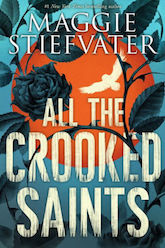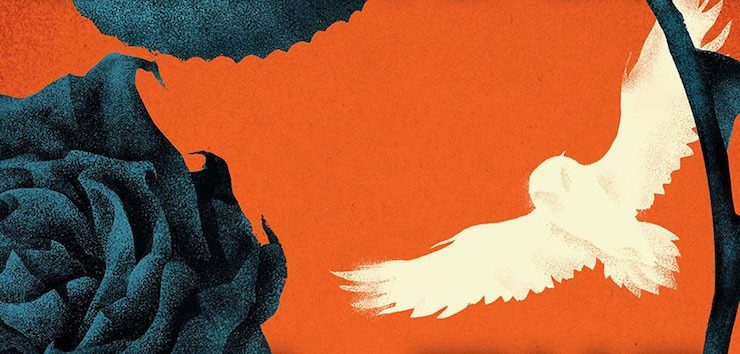The Colorado desert is a place for miracles and for science. The Soria cousins—Daniel, Beatriz, and Joaquin—are all aware of this in their own separate ways. Miracles are a family tradition, a trade practiced for generations in Mexico and then moved across the border during the Revolution, but in All the Crooked Saints the youngest generation must decide for themselves how to carry that tradition properly. Fear and need, speech and silence: Stiefvater’s lyrical foray into magical realism offers a unique perspective on the dualities of meaningful connection.
Stiefvater is a writer more than capable of constructing both long and short narratives. Her recently concluded series The Raven Cycle, as discussed at length here, is a massive tale spanning four novels—but The Scorpio Races (2011) is a well-regarded standalone novel. All the Crooked Saints falls into the second category.
Spoilers.
“On the night this story begins, both a saint and a scientist were listening to miracles,” and so ends the introduction. The miracles the Soria family grant come in two parts. For the first, a pilgrim’s inner darkness is made manifest. The second miracle comes when the pilgrim understands, via the highly literal form the first miracle takes, how to banish that darkness and recover from it. The problem at the start of the novel is that the Soria family, out of fear of bringing their own darkness, have stopped communicating with their pilgrims. Instead, Daniel—our young Saint—grants the first miracle and then the family allows the pilgrims to stay indefinitely without assistance or counseling through the process.
 This goes poorly when, out of love, Daniel helps one of the pilgrims and then banishes himself to the desert when his darkness comes upon him. Beatriz and Joaquin must then take it upon themselves to break the taboo and try to heal him, as well, using their pirate radio station. Tony and Pete, our outsiders, are in search of a miracle and a box truck respectively, and also have their parts to play in this familial drama.
This goes poorly when, out of love, Daniel helps one of the pilgrims and then banishes himself to the desert when his darkness comes upon him. Beatriz and Joaquin must then take it upon themselves to break the taboo and try to heal him, as well, using their pirate radio station. Tony and Pete, our outsiders, are in search of a miracle and a box truck respectively, and also have their parts to play in this familial drama.
It is difficult to describe the action of All the Crooked Saints, as it is half-dreaming and half-concrete, a metaphor about metaphors in the grand tradition of all magical realist novels. Marisita, in her wedding dress covered in butterflies, lives under a rainstorm even indoors; Padre Jiminez is a man with the head of a coyote. The narrator speaks directly of matters like miracles and radio waves, owls of all species loitering around the Soria homestead, a fighting rooster that must stare down his own reflection to become calmed. The fantastic is literal and the literal is fantastic.
One of the primary tropes of magic realism that Stiefvater embraces to the fullest in All the Crooked Saints is its didacticism. There is no purpose to turning a man into a twenty-foot giant with the first miracle if not to make a direct point about his fear of being observed; there is no purpose in having a first dance on an unlit stage be the thing that all the other members of the family observe like a spell cast upon them without then noting their changed outlooks, one by one.
Much of the novel takes the form of observation, extrapolation, and explanation—though this is a desert novel, the prose is verdant. It creates a strange dichotomy in terms of pacing, one that I’m still unsure of my response to. One the one hand, the action takes place over a brief period of time and is rather straightforward so it would seemingly be a smooth, fast reading experience. On the other hand, the novel spends a great deal of time talking to the reader about its ideas, its metaphors, and its arguments—so it becomes dense, poetic, slow to maneuver through.
For example: a thing the person wants, a thing the person fears. Characters are introduced in this fashion, one by one, an intimate knowledge gifted immediately to color their actions and reactions in the mind’s eye throughout the narrative. The novel is also full of observations such as this:
We almost always can point to that hundredth blow, but we don’t always mark the ninety-nine other things that happen before we change.
At times, the didactic speaking-to of the narrator can tread on overwhelming but Stiefvater generally manages to ease up right before it gets to be too much. A reader’s mileage may, of course, vary on this point. I appreciated the homage to the magical realist genre and the approach to the lyrical omniscience of the narrator, both in practice and in theory, but a reader expecting a more organic experience might have difficulty with the pacing and style. The philosophical grounding of the text is engaging, the asides deft and clever, but it does require a great deal of emotional labor.
All the Crooked Saints, ultimately, is a set of brilliant moments structured around a simple plot—a frame to make observations about human nature or the world’s nature and to give the reader a great deal of material to reflect upon at leisure. It’s philosophical, metaphorical, and driven by the urge to observe other people in their natural habitat while also offering them succor and guidance. Overall, it’s a book that drips with love and approaches its characters with a whole-hearted delight in their differences, similarities, and connections. While it has its flaws—the pacing and the density of the prose sometimes don’t balance well with the narrative—it is a comforting and comfortable novel with a deep heart.
It is also admittedly difficult for me the avoid mentioning Stiefvater’s other work here, so I’ll limit myself to the observation that this feels like the sort of novel written as a passionate attempt to do something quite different from the last thing. It has a sense of sprawling excitement and engagement; it’s bursting with the delight of a writer who is exploring a fresh style and fresh tropes. The experience translates well for a reader of her other works, given that it would be difficult to pick up something similar to The Raven Cycle directly after finishing it. Stiefvater here demonstrates an appreciable stylistic range though her concerns remain similar: healing and connection for humans seeking other humans to make a home in. Found families, the love of friends and partners, the possibility of repairing wounded relationships—it’s all there, but from this angle, it takes on a new look.
It feels a bit like taking a breath of crisp desert air before going on to the next project, the next connection, the next miracle.
All the Crooked Saints is available from Scholastic.
Lee Mandelo is a writer, critic, and editor whose primary fields of interest are speculative fiction and queer literature, especially when the two coincide. They have two books out, Beyond Binary: Genderqueer and Sexually Fluid Speculative Fiction and We Wuz Pushed: On Joanna Russ and Radical Truth-telling, and in the past have edited for publications like Strange Horizons Magazine. Other work has been featured in magazines such as Stone Telling, Clarkesworld, Apex, and Ideomancer.










